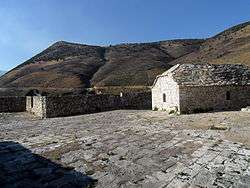Porto Palermo Castle
| Porto Palermo Castle Kalaja e Porto Palermos | |
|---|---|
| Himarë, Albania | |
|
Porto Palermo Castle | |
 Porto Palermo Castle Kalaja e Porto Palermos | |
| Coordinates | 40°03′44″N 19°47′26″E / 40.062317°N 19.790475°E |
| Site information | |
| Owner |
|
| Controlled by |
|
| Site history | |
| Built by | final form created by Ali Pasha of Tepelena |
| Wikimedia Commons has media related to Porto Palermo Castle. |
Porto Palermo Castle (Albanian: Kalaja e Porto Palermos) is a castle near Himarë in southern Albania. It is situated in the bay of Porto Palermo, a few kilometers south of Himarë along the Albanian Riviera. Huffington Post ranked Porto Palermo first among 15 Undiscovered European Destinations for 2014.[1] The area together with Llamani beach will be proclaimed a protected area holding the status of Protected Landscape by the Albanian Government.[2]
History

The well preserved castle is commonly, but wrongly, asserted, by guide books and the local tourist guides, to have been built in early 19th century by Ali Pasha of Tepelena.[3] This is untrue as it has been built prior to the evolution of the star fort design. Most probably it was built by the Venetians as it could be relieved by sea and it has the same triangular plan with round towers found in the Venetian fort at Butrint. Its design is very unusual in having no courtyard. Normally castles had provision for housing some horses, if only to receive and send messengers. In 1921 the castle was called Venetian.[4] At that time the identity of its builders ought to have been clear, from a plaque above the entrance gate. This plaque is now missing but the weathering of the stones clearly shows that it has not been missing for many decades. Almost certainly this plaque had a carving of the lion of St. MarkPorto Palermo Castle is a castle near Himara in southern Albania with an intriguing history. It is situated in the closed bay of Porto Palermo, a few kilometers south of Himarë, and makes nearly an island that is connected to the mainland by a narrow strip of land. The fort served as former Soviet submarine base during the communist regime in Albania, and nowadays its semi abandoned tunnel and barrack attract attention of visitors, as well as the stronghold walls and gates built by the powerful Ali Pasha of Ionina.
By the middle of the 17th century the Ottoman Empire system of administration of vilayets of sanjaks /provinces/ changed into the near-autonomous governance of local rulers who were known as pashas. At the end of the 18th century the sultan appointed a certain Ali from Tepelen as the governor of the most of the Epirus /of the present day southern Albania/ and the large part of the Greek mainland, with his court at Ionina – Yannina. The ancestors of Ali were Christian Skipetars, and became Mussulmans under the Turkish invasion. As young fellow, Ali was patrolling highroads and lanes, with his gun on his shoulder and his yataghan in his belt, attacking, holding for ransom, or plundering all whom he encountered. Afer some years of this profitable business, he found himself a wealthy man and came to power with a distinguished and honourable rank among the beys of the country..
The castle would have been vulnerable to cannon fire from the hill above and this also suggests an early date for its construction when cannon had not developed the range they had later. In 1662 the Venetians feared the Turks would recondition it.[5] In 1803 Ali Pasha offered the castle and port to the Royal Navy. At which time the fort only had 4 or 5 cannon implying that Ali Pasha did not see the fort as important for him.[6] Leake visited the fort and noted that the garrison consisted of 10 men with two four-pounders.[7] Pouqueville in 1806 reports, "The tower or fort stands on the southern point of the entrance, connected with the continent by a low narrow isthmus. It consists of a square with bastions, having a few guns, of no service either to command the entrance or to protect the shipping at anchor. Near it are some warehouses, a custom-house, and a Greek church." [8]
See also
References
- ↑ "15 Undiscovered European Destinations". Huffington Post. 7 April 2014.
- ↑ http://www.mjedisi.gov.al/files/userfiles/Transparence_dhe_Pjesmarrje/Draft_VKM-Gjiri_Portopalermos-Llamani_2015.docx
- ↑ Ndarurinze, Renate (2008). Albanien entdecken: Auf den Spuren Skanderbegs (in German). Berlin: Trescher Verlag. p. 243. ISBN 3-89794-125-2.
- ↑ Scriven, George P. (April 1921). "Some Highways of Albania and a Forgotten Riviera". Geographical Review. American Geographical Society. 11 (2): 198–206. doi:10.2307/207325. JSTOR 207325.
- ↑ p191 “Eternal Butrint” by R.Hodges 2006 London
- ↑ p 86 J. W. BAGGALLY 1938 Ali Pasha and Great Britain Basil Blackwell: Oxford
- ↑ http://www.albanianhistory.net/texts19_1/AH1804.html
- ↑ http://www.albanianhistory.net/texts19_1/AH1806.html
Coordinates: 40°03′43″N 19°47′28″E / 40.062°N 19.791°E

